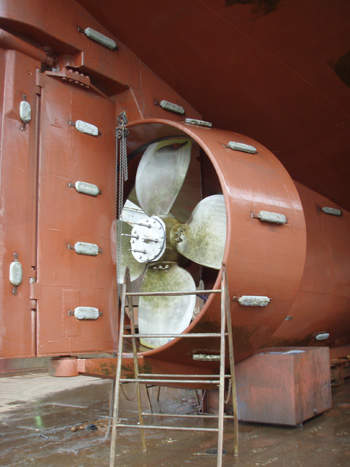I did try Bing for a search, but all I found was information for a sailboat that only lasted a year, but something like a 100 meter ship must last longer than a year, right?
The two main types of bottom paint are ablative bottom paint and hard. They both usually contain copper to help reduce marine growth. The hard style usually contains a lot more copper in it because as it oxidizes it become less effective. The ablative style can contain a lot less copper because it is designed to be softer and the oxidation is designed to slough off. Every fisherman I know paints their boat once a year.
Ablative type ('self polishing) anti-fouling paint up to 5 yrs. Although depending on the dry docking schedule of the ship (for other purposes) it might not be worth it to get a paint that lasts that long. And it’s almost never worth trying to go past 5 yrs since merchant ships normally need a fairly extensive dry dock period for ‘special survey’ by the ship’s classification society (for insurance purposes) every 5 yrs. For painted floating structures (oil platforms etc) there are paints that last longer.
Large commercial and cruising ocean-going vessels use a hard epoxy or polysiloxane anti-fouling coatings which can last up to five years in regular service. These require special preparation and treatment that is beyond what pleasure boat or small commercial operators (who can easily pull a boat out for annual maintenance) need to do to protect their vessels but are necessary for boats that are in constant service and for which any dry maintenance is a costly and laborious effort.
Stranger
Copper based paints are starting to be phased out because they poison the marine environment.
Looks like large ships have a 5 year dry dock requirement and the paint thickness and type are designed to match that as best they can. Here is a little light reading
For offshore oil platforms (and large ships too) there is active corrosion Control (in addition to paint which is just a barrier).
One of the popular ways of doing this is to attach sacrificial anodes to marine structures.
Thank you all … every year sounded a little expensive. Now I can divide it by 4 or 5
and thank you Cory I didn’t know about the insurance
Well. I have never painted my bottom, so I have no idea of how long it would last on a ship - I would not know where to get such paint.
It would depend on how often the seamen get all up in it surely?
Interesting.
Is that five years mandatory or with and without inspections? The Navy ship I went on went at least eight years before dry dock. I only say at least eight as I left the Navy after that. However, I don’t think one can get insurance on a warship. I want to say it went closer to twelve before they dry-docked it.
Inspections were often though.
It might also depend on the port? Some ports might be in a bay and have brackish water whereas some could be fresh and others salt-water.
Docking intervals as long as 8 yrs used to be unheard even for warships, they were much shorter. Now AFAIK yes that is typical with discussion of further increase. Also some cases classification societies have approved schemes to only drydock merchant ships for special survey at 7.5 not 5 yrs, but 5 yrs remains typical.
But warships and merchant ships live very different lives in lots of ways. Most merchant ships operate almost all the time. Even for the very high-tempo (by intl standards) USN utilization is considerably less, in other navies often a small fraction as much. Then warships are, obviously, much more complicated and they are typically also modernized not just maintained over their typically longer lives. So when warships do go into drydock it can be in for several months to 3+ yrs (say destroyer’s Docking Selective Restricted Availability on one hand or a carrier’s Refueling Complex Overhaul on the other). And it upsets everything about the ship’s operation and its very large (by merchant ship standards) crew to be in dock. So the idea has become to stretch those intervals very far, and ship then becomes non-operational for a relatively long time.
A long special survey of a merchant ship in dock is a few weeks. That would indicate significant problems to be corrected. It might be a week. But it involves stuff like pulling out the tail shaft for inspection, a circus trick to do that afloat. And other stuff that’s just easier in dock. And the much smaller crews are changing over all the time anyway. Merchant ships also used to dock a lot more often. Five years assumes you can do some inspections that used to be done in drydock while afloat, like valves that let water in for engine cooling for example. Divers can put blanks over the outside of the inlet, used to be you’d just dock the ship to inspect in the inside of those valves. Similar measures have been applied to warships which also used to drydock a lot more frequently.
